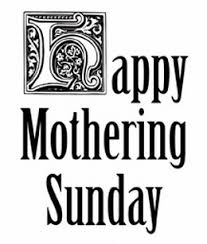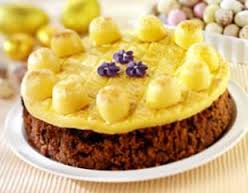The Fourth Sunday of Lent, Mid-Lent Sunday, Laetare Sunday, in the Anglican tradition is also called Mothering Sunday. The Introit for the day, from Isaiah, is “”REJOICE [Laetare] ye with Jerusalem: and be glad with her, all ye that love her: rejoice for joy with her, all ye that mourn for her: that ye may suck, and be satisfied with the breast of her consolations. I was glad when the said unto me: We will go into the house of the Lord.” The traditional Epistle from Galatians incudes the passage “But Jerusalem which is above is free; which is the mother of us all. For it is written, Rejoice, thou barren that bearest not; break forth and cry, thou that travailest not: for the desolate hath many more children than she which hath an husband. Now we, brethren, as Isaac was, are the children of promise.” The traditional Gospel tells of Jesus’ feeding of the five thousand.
From these passages of Scripture arose the custom of visiting the mother church, that is, the church in which one was baptized. Young people who had left their home village to work as domestic servants were given the day off to see their mothers and to bring a gift of food.
Henry Bourne, Curate of All-Hallows, in Newcastle upon Tyne, in 1727 explained
On this, “The fourth SUNDAY in Lent… having now brought us to the Middle of the thorny Way of Mortification, [the Church] cheers and comforts us with the End of our Journey and the Promise of Refreshment, lest we faint upon the Road…
The GOSPEL tells of Christ’s Relieving the five Thousand miraculously; intimating to us, that after the Hunger we suffer here, we shall be refreshed by our Lord…
THIS Sunday is also called Dominica de Panibus, the Sunday of the Loaves; or Dominica Refectionis, the Sunday of Refreshment: Because it does not treat of Mortification, but tells of the heavenly Jerusalem, and that Refreshment our Saviour will there give us.
During the Lent fast, people did not eat from sweet, rich foods or meat. However, the fast was lifted slightly on Mothering Sunday and many people prepared a Simnel cake to eat with their family on this day. A Simnel cake is covered with marzipan and twelve balls of marzipan to represent Jesus and the eleven faithful apostles.
Robert Herrick (1591-1674) refers to this custom in this poem:
I’ll to thee a Simnell bring
‘Gainst thou go’st a-mothering,
So that when she blesses thee
Half that blessing thou’lt give me.
A modern carol by George Hare Leonard refers to these customs:
So I’ll put on my Sunday coat,
And in my hat a feather,
And get the lines I writ by rote,
With many a note,
That I’ve a-strung together.And now to fetch my wheaten cake
To fetch it from the baker,
He promised me, for mother’s sake,
The best he’d bake
For me to fetch and take her.Well have I known, as I went by
One hollow lane, that none day
I’d fail to find – for all they’re shy –
Where violets lie,
As I went home on Sunday.My sister Jane is waiting-maid
Along with Squire’s lady;
And year by year her part she’s played
And home she stayed
To get the dinner ready.For mother’ll come to Church you’ll see-
Of all the year it’s the day-
‘The one,’ she’ll say, ‘that’s made for me’
And so it be:
It’s every Mother’s free day.The boys will all come home from town
Not one will miss that one day;
And every maid will bustle down
To show her gown,
A-mothering on Sunday.It is the day of all the year,
Of all the year the one day;
And here come I, my mother dear,
And bring you cheer,
A-mothering on Sunday.
The music is from a medieval German carol “Ich weiβ ein lieblich Engelspiel,” here performed by Clara Obscura and here with medieval instruments. It is also appropriate for Lent, the lengthening of days in spring:
Der Winter kalt, der Sünden Zeit
die haben bald ein Ende;
kehr dich zu Gott, der dir verzeiht;
darum ihn bitt mit Herzen und mit Händen!
The winter’s cold, the time of sin, will soon have an end; turn to God, who forgives you, pray to him with hearts and hands!


